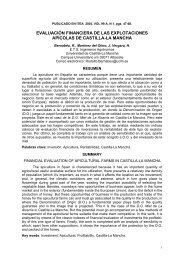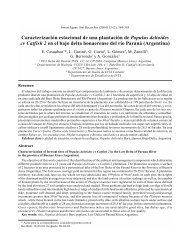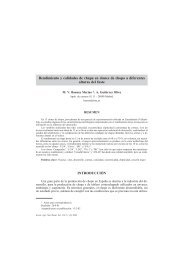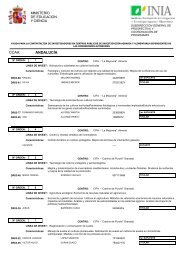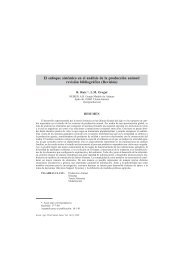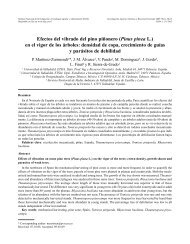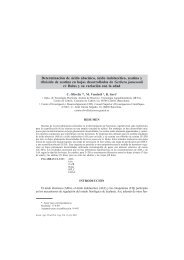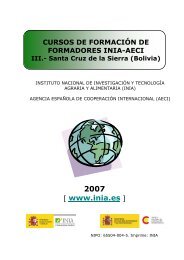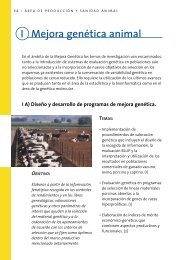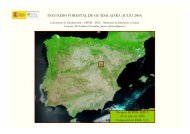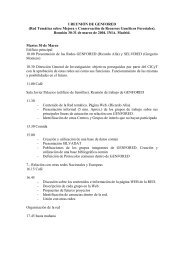Status of medicinal and aromatic plants in - Inia
Status of medicinal and aromatic plants in - Inia
Status of medicinal and aromatic plants in - Inia
Create successful ePaper yourself
Turn your PDF publications into a flip-book with our unique Google optimized e-Paper software.
128<br />
WORKING GROUP ON MEDICINAL AND AROMATIC PLANTS: FIRST MEETING<br />
Medic<strong>in</strong>al <strong>and</strong> <strong>aromatic</strong> plant production <strong>in</strong> the United K<strong>in</strong>gdom<br />
Rosemary Cole<br />
National Herb Centre (NHC), Banbury, United K<strong>in</strong>gdom<br />
Natural solutions are <strong>in</strong>creas<strong>in</strong>gly be<strong>in</strong>g sought to agrochemical, pharmaceutical <strong>and</strong> food<br />
issues <strong>and</strong> the market for herb products is grow<strong>in</strong>g rapidly, putt<strong>in</strong>g an additional stra<strong>in</strong> on<br />
resources as many herb species are wild harvested. A report by Lange (1998) claimed that<br />
70-90% <strong>of</strong> herbal products imported <strong>in</strong>to Germany are wild harvested. Current production <strong>of</strong><br />
herbs <strong>in</strong> the UK occupies a relatively small area (ca. 4000 ha), mostly <strong>of</strong> cul<strong>in</strong>ary herbs. Herb<br />
companies still import large quanitites <strong>of</strong> herbs which could be grown <strong>and</strong> there is<br />
considerable potential for expansion to provide <strong>in</strong>dustrial raw materials. In order to realize this<br />
potential <strong>and</strong> thus meet the UK government's policy aim <strong>of</strong> encourag<strong>in</strong>g the development <strong>of</strong><br />
crops for <strong>in</strong>dustrial applications, a number <strong>of</strong> projects have been <strong>in</strong>itiated. But evidence <strong>of</strong><br />
the biological activity <strong>of</strong> these materials, the feasibility <strong>and</strong> economics <strong>of</strong> UK production <strong>of</strong><br />
these crops needs to be obta<strong>in</strong>ed.<br />
A number <strong>of</strong> factors have been shown to <strong>in</strong>fluence the yield <strong>and</strong> composition <strong>of</strong> essential<br />
oils <strong>and</strong> bioactives from herb crops. These <strong>in</strong>clude genetics (orig<strong>in</strong>, variation),<br />
morphogenesis (leaf position <strong>and</strong> age, harvest, flower<strong>in</strong>g), environment (temperature, day<br />
length <strong>and</strong> light <strong>in</strong>tensity) <strong>and</strong> f<strong>in</strong>ally agricultural practices (nutrition, irrigation,<br />
propagation, harvest<strong>in</strong>g <strong>and</strong> extraction). Selection <strong>of</strong> plant material <strong>and</strong> the optimization <strong>of</strong><br />
agricultural practices is vital for the production <strong>of</strong> high quality herbs, essential oils <strong>and</strong><br />
extracts. The need to know how the crop has been produced (traceability <strong>of</strong> raw materials) <strong>and</strong><br />
concern over the quality <strong>of</strong> imports (pesticides, heavy metals) suggests there is scope to supply<br />
extracted natural products from herbs grown <strong>in</strong> the UK to provide high quality raw materials<br />
for <strong>in</strong>dustry. There is potential to develop the UK herb <strong>in</strong>dustry, which encompasses a number<br />
<strong>of</strong> small- <strong>and</strong> medium-sized companies, if they meet the str<strong>in</strong>gent specifications, supply cha<strong>in</strong><br />
<strong>and</strong> quality requirements. It is possible to capitalize on this opportunity with a better<br />
knowledge <strong>of</strong> cultivar selection, how herbs can best be grown under UK conditions <strong>and</strong> by<br />
develop<strong>in</strong>g new techniques which may lead to safer <strong>and</strong> more efficient extraction <strong>of</strong> natural<br />
products.<br />
Below are three projects <strong>in</strong> which the National Herb Centre is <strong>in</strong>volved.<br />
The Rapfi project (Rosemary antioxidants for the pharmaceutical <strong>and</strong> food <strong>in</strong>dustries) is part <strong>of</strong><br />
the Competitive Industrial Materials from Non Food Crops (CIMNFC) programme <strong>and</strong> is a<br />
collaboration between the National Herb Centre (NHC), Department <strong>of</strong> Biology at the<br />
University <strong>of</strong> Read<strong>in</strong>g, Department <strong>of</strong> Sonochemistry at the University <strong>of</strong> Coventry,<br />
J.K. K<strong>in</strong>gs <strong>of</strong> Coggeshall (Seedsmen), Advanced Phytonics (Extraction), Langford Electronics<br />
(Ultrasonic equipment) <strong>and</strong> Checkmate (Audit trail). The project objectives are to select<br />
rosemary accessions for high antioxidant activity, enhance antioxidant activity through the<br />
use <strong>of</strong> elicitors, produce a predictive model relat<strong>in</strong>g antioxidant activity to UV radiation, to<br />
develop an affordable extraction process <strong>and</strong> produce an audit trail for the whole production<br />
process.<br />
Accessions <strong>of</strong> Rosmar<strong>in</strong>us <strong>of</strong>fic<strong>in</strong>alis were collected from throughout Europe. In total<br />
80 accessions have been trialed <strong>and</strong> analyzed at the National Herb Centre. Results have<br />
shown that antioxidant potential as measured by the free radical scaveng<strong>in</strong>g activity <strong>and</strong><br />
cha<strong>in</strong> propagation correlated with carnosic acid (r=0.82 <strong>and</strong> 0.53 respectively). Rosemary<br />
antioxidants also reduced production <strong>of</strong> "<strong>of</strong>f flavours" such as hexanal. Rosemary accessions<br />
were therefore selected for antioxidant activity by screen<strong>in</strong>g for carnosic acid concentration.<br />
Field trials (30 accessions <strong>and</strong> 6 replicates) had been planted September 1999 <strong>in</strong> three




